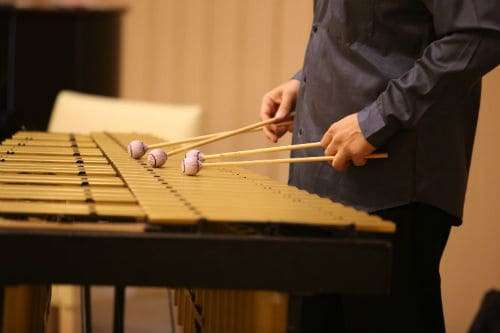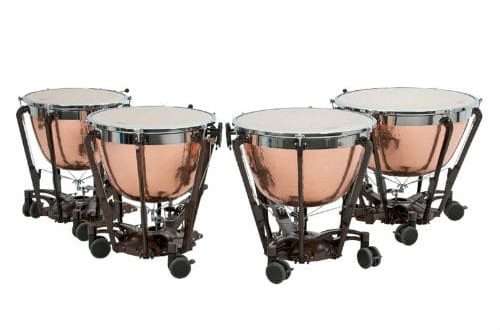
Vibraphone: what is it, composition, history, difference from xylophone
The vibraphone is a percussion instrument that has had a great influence on jazz music culture in the United States.
What is a vibraphone
Classification – metallophone. The name glockenspiel is applied to metal percussion instruments with different pitches.
Outwardly, the instrument resembles a keyboard instrument, like a piano and a pianoforte. But they play it not with fingers, but with special hammers.

The vibraphone is often used in jazz music. In classical music, it ranks second among the most popular keyboard percussion instruments.
Tool design
The construction of the body is similar to the xylophone, but it has a difference. The difference lies in the keyboard. The keys are located on a special plate with wheels on the bottom. The electric motor responds to keystrokes and activates the blades, the action of which affects the vibrating sound. Vibration is created by overlapping tubular resonators.
The tool has a damper. The part is designed to muffle and soften the sound being played. The damper is controlled by a pedal located at the bottom of the vibraphone.
The metallophone keyboard is made of aluminium. Holes are cut along the entire length of the keys to the end.
The sound is produced by hammer blows on the keys. The number of hammers is 2-6. They differ in shape and hardness. The most common round head shape. The heavier the hammer, the louder and louder the music will sound.
The standard tuning is a range of three octaves, from F to middle C. A range of four octaves is also common. Unlike the xylophone, the vibraphone is not a transposing instrument. In the 30s of the last century, manufacturers produced soprano metallophones. The timbre of the soprano version is C4-C7. The “Deagan 144” model was reduced, ordinary cardboard was used as resonators.
Initially, the musicians played the vibraphone while standing. With the development of technology, some vibraphonists began to play while sitting, in order to more conveniently use both feet on the pedals. In addition to the damper pedal, effects pedals commonly used on electric guitars have come into use.

History of the vibraphone
The first musical instrument called the “Vibraphone” went on sale in 1921. The release was handled by the American company Leedy Manufacturing. The first version of the metallophone had many minor differences from modern models. By 1924, the instrument was quite widespread. Popularization was facilitated by the hits “Gypsy Love Song” and “Aloha Oe” by pop artist Luis Frank Chia.
The popularity of the new instrument led to the fact that in 1927 JC Deagan Inc decided to develop a similar metallophone. Deagan engineers did not completely copy the structure of a competitor. Instead, significant design improvements were introduced. The decision to use aluminum instead of steel as the key material improved the sound. Tuning has become more convenient. The damper pedal was installed in the lower part. The Deagan version quickly bypassed and replaced its predecessor.
In 1937, another design modification took place. The new “Imperial” model featured a two and a half octave range. Further models received support for electronic signal output.
After World War II, the vibraphone spread throughout Europe and Japan.
Role in music
Since its inception, the vibraphone has become an important component of jazz music. In 1931 percussion master Lionel Hampton recorded the song “Les Hite Band”. It is believed that this is the first studio recording with a vibraphone. Hampton later became a member of the Goodman Jazz Quartet, where he continued to use the new glockenspiel.

The Austrian composer Alban Berg was the first to use the vibraphone in orchestral music. In 1937, Berg staged the opera Lulu. French composer Olivier Messiaen presented a number of scores using metallophone. Among the works of Messiaen are Tuarangalila, The Transfiguration of Jesus Christ, Saint Francis of Assisi.
Russian composer Igor Stravinsky wrote “Requiem Canticles”. Character composition by heavy use of the vibraphone.
In the 1960s vibraphonist Gary Burton gained popularity. The musician distinguished himself by innovation in sound production. Gary developed the technique of playing with four sticks at the same time, 2 per hand. The new technique made it possible to play complex and varied compositions. This approach has changed the view of the tool as somewhat limited.
Interesting Facts
An updated vibraphone from Deagan in 1928 bore the official name “vibra-harp”. The name arose from the vertically arranged keys, which made the instrument resemble a harp.
The Soviet song “Moscow Evenings” was recorded using a vibraphone. The debut of the song took place in the film “In the days of the Spartakiad” in 1955. An interesting fact: the film went unnoticed, but the song gained wide popularity. The composition received popular recognition after the start of broadcasts on the radio.
Composer Bernard Herrmann actively used the vibraphone in the soundtrack of many films. Among his works are the painting “451 degrees Fahrenheit” and thrillers by Alfred Hitchcock.





